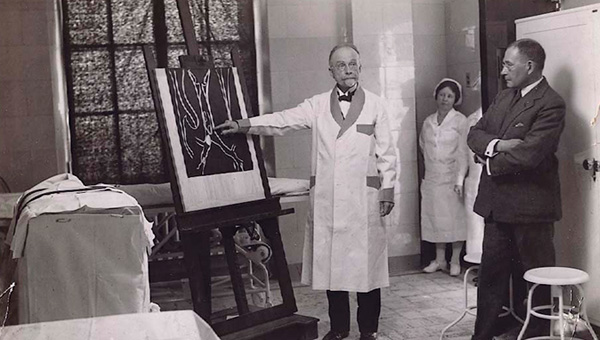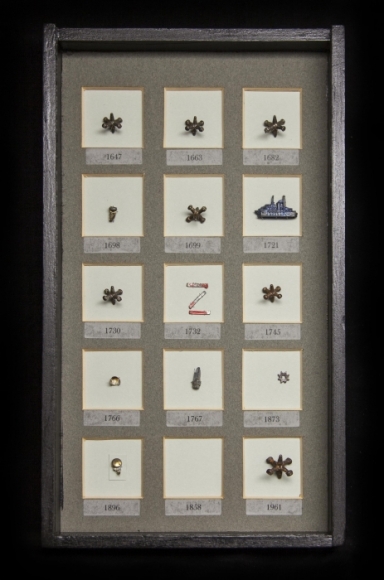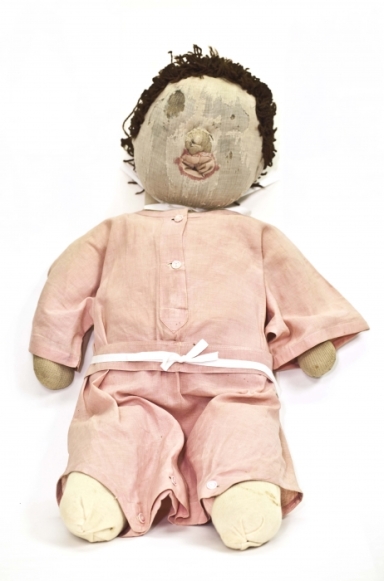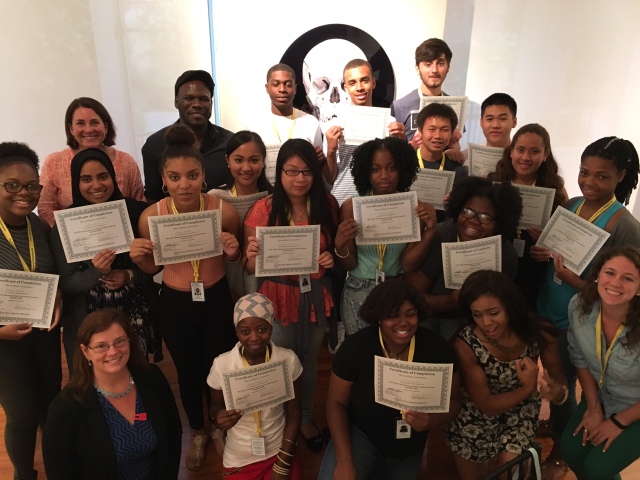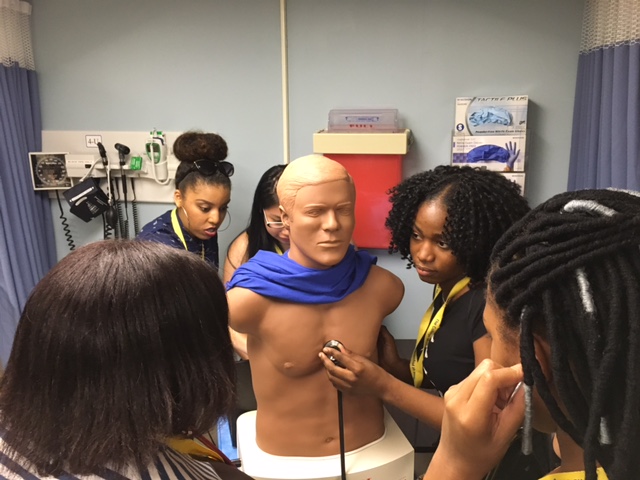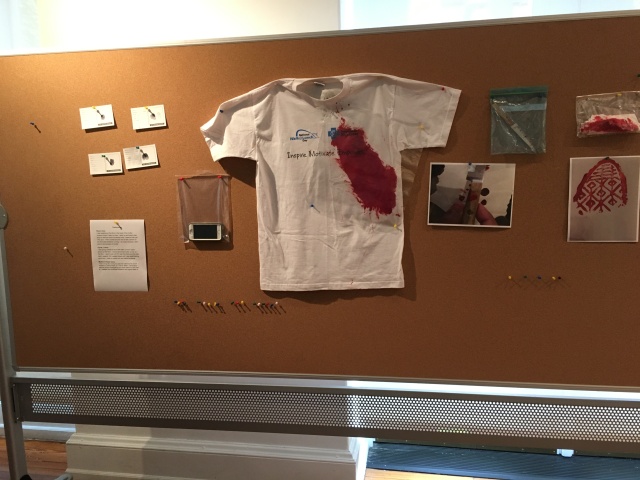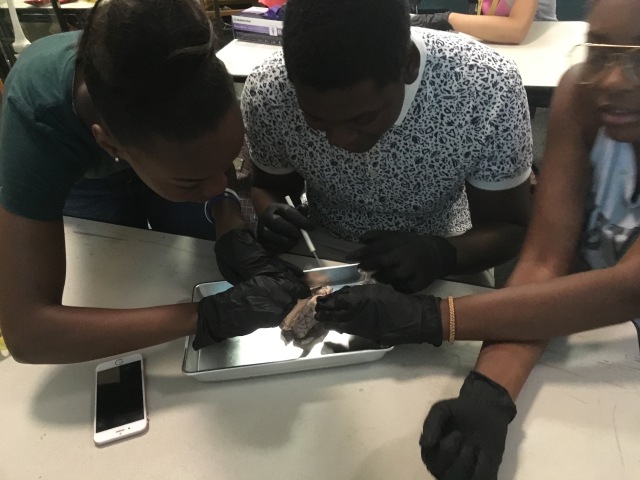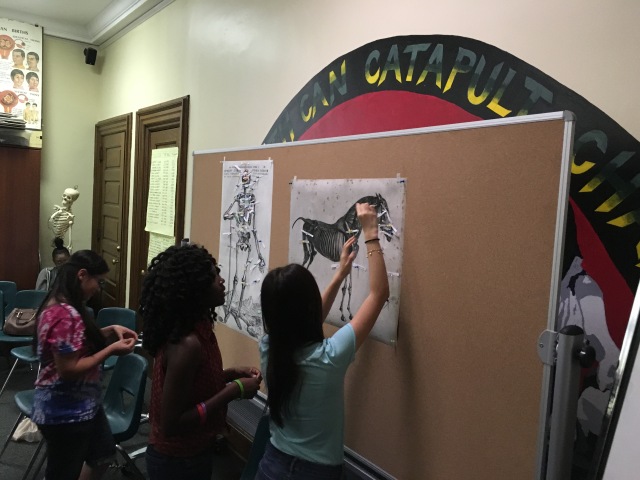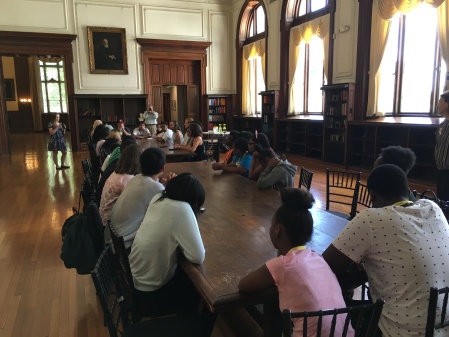
This thoroughly-researched piece is by Sarah Henry, an instructor at Delaware County Community College and tour guide at the Mütter Museum.–KI
I have blue eyes and I have always been interested in exploring my own genetic origins, but I’m not the only one interested in this genetic trait. Countless songs and poems reference people with blue eyes, whether considered a mark of beauty, a representation of sadness, or, in certain cultures, a sign of the oppressor. But blue eyes, so popular in art, are relatively new in human evolution, as new as the invention of writing itself. My interest in this subject was sparked, in part, by a unique archaeological discovery; in 2006, researchers uncovered the world’s oldest confirmed blue-eyed person, dating to approximately 7,000 years ago. This discovery helped to confirm theories regarding the familial relationship of nearly all blue-eyed individuals. This article will exam the genetic origins of blue eyes in humans, the spread of the blue-eyed gene, and the future of this genetic trait.
Genetics: How Do They Work?
The basic explanation of eye-color works like this: a person needs only one dominant brown-eyed gene (from one parent) to be brown-eyed but needs to have two recessive blue-eyed genes (one from each parent) to be blue-eyed. You have probably seen this explanation accompanied by a simple Punnet square (Image 1) in your science textbooks. However, new studies illustrate that the genetics behind eye color are not so straightforward. There are actually two separate genes that control eye color in humans. In his article, “Blue Eye Color in Humans,” Hans Eiberg writes, “Blue/Brown eye-color are known to the public as a school example of inheritance of monogenetic [one gene] inheritance, however, the variation in pigment concentration and the iris suggest the eye color genetics to be far more complex as supported by recent data.” In other words, eye color is controlled not by one gene passed from parent to offspring, but by two genes working in tandem; a more complex chart would take both of these genes into consideration (Image 2).

Image 1

Image 2
These genes are called OCA2 and HERC2 (represented as O, o, H and h in Image 2). The simplified explanation is that the OCA2 gene controls pigment in the stroma (the tissue and blood vessels) of the iris (the colored part of the eye around the pupil) and the HERC2 gene is needed to help turn on the OCA2 gene to cause it to produce this pigment, resulting in brown eyes. If a person has a non-functioning OCA2 gene, they will always have blue eyes, because the HERC2 gene can’t make the broken OCA2 gene work. Likewise, if a person has a HERC2 gene which doesn’t work, the OCA2 gene will “underachieve,” failing to produce enough pigment to make brown eyes, resulting in blue eyes. These two genes aren’t directly related to each other, yet they affect each other. In this dependent relationship, both of these genes must work to give an individual brown eyes, a genetic relationship known as “epistasis.” Because of this process, it is actually possible (although rare) for two blue-eyed parents to have a brown-eyed child. If one parent passes on a working HERC2 gene and one passes on a working OCA2 gene, rather than the broken version of each, the resulting child could have brown eyes (Image 3). In addition to this more complex explanation of eye color as an inherited trait, this new study also suggests that all blue-eyed people stemmed from a single common ancestor.
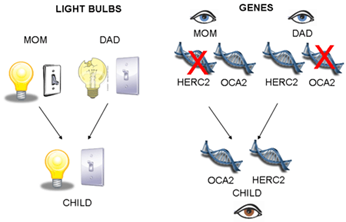
Image 3
How Do We Know All Blue-eyed People Are Related?
Homo sapiens (modern humans) emerged around 200,000 years ago in Africa, but the mutation that causes blue eyes did not appear until sometime around 10,000 years ago. In a study conducted by Professor Hans Eiberg and a team from the University of Copenhagen, researchers examined mitochondrial DNA from 155 blue-eyed subjects from Denmark, two from Jordan, five from Turkey, and 45 brown-eyed candidates, looking at the locus (specific location or position of a gene) responsible for brown or blue eyes. The result was the discovery that more than 97% of blue-eyed people share the single H-1 haplotype (a group of genes within an organism that was inherited together from a single parent). Eiberg and his team write, “A shared haplotype among blue-eyed individuals is almost perfect and suggests the blue color phenotype is caused by a founder mutation.” This means that the vast majority of people with blue eyes share a single inherited genetic mutation, rather than each person with blue eyes possessing a unique mutation. The study also tested seven blue-eyed Mediterranean individuals unrelated to the Danish participants as a control group. They, too, carried the H-1 haplotype. These individuals with the H-1 haplotype all inherited the same switch at the same location in their genetic coding, whereas, brown-eyed individuals have a number of variations in melanin production and DNA, with brown-eyed phenotypes being spread out between haplotypes H-5 and H-10. In short, almost all blue-eyed people came from a single ancestor, which is proven by the possession of the exact mutation at the same location in their genetic coding. That leads us back to the blue-eyed man from the article that sparked this entire investigation.
Why is This Stone Age Body in Spain so Important?
In 2006, researchers discovered a 7,000 year old body from the Stone Age in the La Brana cave system in Leon in Northern Spain (Image 4). Genetic testing determined that this man had blue eyes. It was not in itself unusual, but what is remarkable is that he is the earliest known person with blue eyes. Far from being a fair-haired, far-skinned man that we may have expected, his genetics reveal he’s a mixture of other traits. Although he’s closely related to the modern residents of Scandinavia, he also carries the dark-skinned genes of an African, as well as curly dark hair and lactose intolerance (Image 5). So if blue-eyed people originated near the Black Sea and were concentrated in Northern Europe, how did our mystery man end up in Spain?
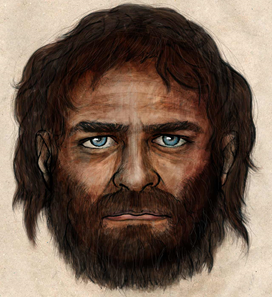
Image 4
In order to answer this question, we need to delve into Stone Age migratory patterns. According to Pickrell and Reich, there are two theories of cultural migration: Demographic Stasis vs. Demographic Change. In Demographic Stasis, inhabitants living in a particular region are the descendants of the first people to arrive in that region, meaning the people in a certain area were never integrated into or replaced by people from a second migration. Demographic Change posits that inhabitants of a region descended from people who arrived during periods of technological or cultural change, replacing the previous inhabitants. These periods of change can be tracked by sudden changes of culture in the archaeological record. Essentially, if we can track people by their technology (things like tools and weapons) and implements of culture (things like pottery and jewelry), we can track how people migrated from one place to another and brought their genetic traits with them.

Image 5
Specifically, we can see this during the Neolithic (New Stone Age) Revolution, a period of time where humans began to cultivate crops, domesticate animals, and use polished stone tools. Prior to the Neolithic Revolution, almost all the world’s inhabitants subsisted primarily by hunting and gathering, but after the Neolithic Revolution, small pockets of farming emerged, first in the Fertile Crescent, China, and India and then spreading across Eurasia. The Neolithic Revolution occurred between 6,000-10,000 years ago, and because people were better able to procure a steady source of food, the population increased significantly. The technologies which emerged during this time allow archaeologists and researchers to track cultural migration from the northwestern part of the Black Sea region (where the first humans with blue eyes lived) into the rest of Europe. A study of Armenian haplotypes determined, “…hospitable climatic conditions and the key geographic position of the Armenian Highland suggest that it may have served as a conduit for several waves of expansion of the first agriculturalists from the Near East to Europe and the North Caucasus.” People migrated out of the Caucuses (modern-day Georgia, Azerbaijan, and Armenia) and into other parts of Europe (Image 6). Hovhannisyan, et al. write, “Apparently, the population migration of the first farmers from the Levant could have been both by land to Anatolia and the North Caucasus, and by maritime routes via eastern Mediterranean islands towards continental Europe.” Sparked by the population boom created by the Neolithic revolution, people began migrating faster and farther than ever before.

Image 6
Another study, focusing specifically on the genetics of residents of the Iberian Peninsula (excluding the Basques), indicates a mixture of genetic traits from the Caucuses, Central Asia and North Africa, probably related to migration during the Neolithic Era. A study of eight Bronze Age individuals dated to between 5,500 and 3,500 years ago shows an admixture between existing hunter-gatherer groups and people from later migrations, meaning people who migrated to this area began to blend into the peoples that already lived there by blending both their culture and genetics.
Why Did this Recessive Genetic Trait Survive for Thousands of Years?
How did the blue-eyed gene persist if there’s no overt evolutionary advantage to possessing it? One argument would be that those original groups of people who possessed blue eyes produced offspring with other blue-eyed people in their own group, leading to a population where blue eyes were the norm. However, there are both objective and subjective benefits to possessing blue eyes. Subjectively, possessing blue eyes may just make one individual more sexually attractive to another. Objectively, blue eyes filter light differently than dark eyes (dark eyes, like dark skin, possess more pigment which can protect those organs from sun damage), which make them especially advantageous in the low light of Northern European winters. Because people with light eyes are more sensitive to light, they can see better in areas that lack sufficient sunlight for large portions of the year. Conversely, while light sensitivity (photophobia) proved useful in a world prior to electricity, it actually opens blue-eyed people up to a host of medical problems including an increased risk of macular degeneration, which can ultimately lead to blindness because light eyes are worse at filtering out harmful UV light.
What is the future of blue eyes?
At the turn of the 20th century, 50 percent of people living in the United States had blue eyes. Now, however, people are more likely than ever to marry outside of their ethnic group, leading to more genetically diverse offspring and a decline in blue eyes due to the dominance of the brown-eyed genes. Currently, in the U.S., only 17 percent of the population (1 in 6) has blue eyes and only between 5-8% of people worldwide possess the trait. (Green eyes are even more rare, but they are a topic for another article.) Even though they are new in human history, blue eyes are already on the decline.
Whether used to convey beauty, as one writer notes about the poetry of Longfellow and Romanticism, “It delighted in sentimental musings amid the ruins, in pathetic legend, in dreamy pictures of monks and harpers and knights and radiant maidens with soft blue eyes” or to convey sadness like in the Who song “Behind Blue Eyes,” where Roger Daltry sings, “No one knows what it’s like/ To be the bad man/ To be the sad man/ Behind blue eyes,” or as Kristina Richardson writes in her article regarding the perception of blue eyes in the Islamic Middle Ages, “My preliminary archival work suggests the Medieval Muslim male writers overwhelmingly accepted the characterization of blue and green eyes as unattractive and deviant,” a line of thinking fueled by the brutality of European crusaders who raped, pillaged and murdered in an attempt to reclaim the Holy Land. Blue eyes have been a notable trait in literature across cultures for centuries. Though the future of blue eyes is unclear, nearly all living and dead blue-eyed individuals share a familial relationship through a single genetic mutation. If you have blue eyes or know someone with blue eyes, they are more than likely related to that 7,000 year old man whose remains that researchers found in a remote cave in Spain.
Sources
A. Hoyhannisyan, Z. Khachatryan. M. Haber, P. Hrechdakian, et all. Different waves and directions of Neolithic migrations in the Armenian Highland. Investigative Genetics 5 (2014).
B. Starr. “Eye Color.” TheTech. TheTech, 14 October 2004. <http://genetics.thetech.org/ask/ask59>
B. Starr. “How Blue Eyed Parents Can Have Brown Eyed Children: Two Different Ways to Get Blue Eyes.” TheTech. <http://genetics.thetech.org/how-blue-eyed-parents-can-have-brown-eyed-children>
F.L. Patty. Sidelights on American Literature. “The Shadow of Longfellow.” Century Company, 1922: p. 237.
H. Eiberg, J. Troelsen, M. Nielsen, A. Mikkelsen, J. Mengel-From, K.W. Kjaer, L. Hansen. Blue eye color in humans may be caused by a perfectly associated founder mutation in a regulatory element located within the HERC2 gene inhibiting OCA2 expression. Human Genetics 123 (2008): 177-187.
I. Lazaridis, et all. Ancient human genomes suggest three ancestral populations for present-day European. Nature 513 (18 September 2014): 409-413.
K. Richardson. “Blue eyes in Islamic Middle Ages.” Medievalists. Medievalists, 16 February 2014. <http://www.medievalists.net/2014/02/16/blue-eyes-islamicate-middle-ages/>
J. Bryner. “One Common Ancestor Behind Blue Eyes.” LiveScience. LiveScience, 31 January 2008. <http://www.livescience.com/9578-common-ancestor-blue-eyes.html>
J.K. Pickrell and D. Reich. Toward a new history and geography of human genes informed by ancient DNA. Trends in Genetics Vol. 30, No. 9 (Sept 2014): 377-389.
J. Mengel-From, C. Borsting, J. J. Sanchez, Hans Eiberg, Neils Morling. Human eye colours and HERC2, OCA2 and MATP. Forensic Science International: Genetics 4 (2010): 323-328.
S. Connor. “Revealed: First Ol’ Blue Eyes is 7,000 years old and was a caveman living in Spain.” IndependentUK. IndependentUK, 26 January 2014. <http://www.independent.co.uk/news/science/revealed-first-ol-blue-eyes-is-7000-years-old-and-lived-in-a-cave-9086310.html>
T. Günther, C. Valdiosera, H. Malmström, I Urena, et all. Ancient genomes link early farmers from Atapuerca in Spain to modern-day Basques. PNAS 112 (2015): 11917-11922
University of Copenhagen. “Blue-eyed humans have a single, common ancestor.” ScienceDaily. ScienceDaily, 31 January 2008. <www.sciencedaily.com/releases/2008/01/080130170343.htm>.

